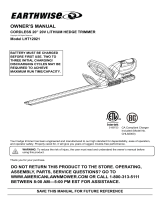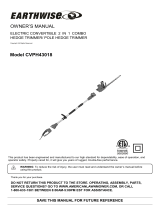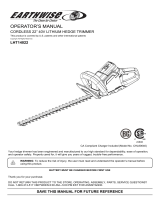Page is loading ...

EHT 4555 - EHT 6060
TAGLIASIEPI ELETTRICO
ISTRUZIONI PER L’USO
I
POWER HEDGE TRIMMER
OPERATING INSTRUCTIONS
TAILLE-HAIE
MODE D’EMPLOI
F
ELEKTRISCHE-HECKENSCHERE
GEBRAUCHSANWEISUNG
D
TIJERAS ELÉCTRICAS PARA PODAR
INSTRUCCIONES PARA SU USO
E
TESOURA DE ARBUSTOS ELÉCTRICA
MODO DE EMPREGO
P
HEGGESCHAAR
GEBRUIKSAANWIJZING
HÄCKSAX
SÄKERHETSINSTRUKTIONER
S
HEKKSAKS
SIKKERHETSINSTRUKSJONER
N
PENSASLEIKKURI
KÄYTTÖOHJEET
MHXANH KËAÄEMATOÓÈAMNÙN
Ïäçãßåò ÷ñÞóçò
HÆKKEKLIPPER
SIKKERHEDSINSTRUKTIONER

Français 1
English 5
Deutsch 9
Español 13
Italiano 17
Português 21
Nederlands 25
Svenska 29
Dansk 33
Norsk 37
Suomi 41
Eëëçíéêá 45

5
ENGLISH
RANGE OF USE
Cutting and trimming of hedges, bushes and
ornamental shrubs in the domestic sector.
All other uses are expressly excluded.
The application of unsuitable maintenance
procedures and the use of inappropriate
components or the removal of safety
devices are extremely dangerous usages .
Pay great attention!
Before the use of the hedgetrimmer, we
recommend you to read the instructions for
use and the safety warnings.
SAFETY INFORMATIONS
Use only suitable accessories approved
for use with the tool.
Always pull the power plug out of the
socket before working on the tool, e.g.
cleaning, removing blockages, inspection
or maintenance.
Pull the plug out immediately if the
mains or extension lead is dam-
aged or severed.Use cord and
extension cord that is defective or
damaged.
When using the tool, always make sure
that safety equipment is fitted.Never try to
use the uncomplete equipment or the unit
that has been tampered with
unauthorized modification.
For safety reasons, the socket used to
power the unit should be backed up by
aresidual current device-operated (FI)
circuitbreaker which can be tripped by a
max. current of 30mA.
Use only a water-jet-proof extension lead
approved for outdoor use (H07RN-F).
Secure extension lead by hanging it in the
pull-relief (
11
11
1
Fig.2).
Before using, inspect tool, extension lead
and plug. Have damaged parts replaced
or repaired only by a specialist.The
blades have to be substituted in pairs.
Always keep extension lead out of the
work area and lay it rearwards away
from the machine.
Always wear suitable clothing! Avoid
wearing loose clothing or jewellery, as
this can get caught in moving parts. It is
recommended to wear tight fitting gloves,
non-slip shoes, long trousers and safety
goggles.
Use always ear protection device. Wear
always boots for your safety. Wearing a
head protection is necessary when there
is the possibility of objects falling.
Tool must not be used in rain or
on wet hedges.
Please read these operating instructions before using the tool for the first time and
keep them with then tool at all times
PACKAGE CONTENTS
11
11
1
FIG.1
1. Safety cutter bar
2. Safety guard
3. Bow-grip with On/Off switch
4. Handle with On/Off switch
5. Pull-relief
6. Transport guard
7. Knock-on protector
TECHNICAL DATA
EHT 4555
Rated voltage V/Hz 230/50
Power rating W 450
Rated no-load speed min
-1
1500
Cutter blade distance mm 24
Length of cut mm 540
Braking time s < 1
Weight kg 3,9
LpA (noise)* dB(A) 90,1
LWA (sounding power) dB(A) 101
Vibration level m/s
2
1,5
EHT 6060
Rated voltage V/Hz 230/50
Power rating W 600
Rated no-load speed min
-1
1500
Cutter blade distance mm 24
Length of cut mm 630
Braking time s < 1
Weight kg 4,1
LpA (noise)* dB(A) 92,2
LWA (sounding power) dB(A) 105
Vibration level m/s
2
1,5
* to ears of operator

6
EHT 4555 - EHT 6060
If it is possible, clear the cutting zone
before to start with the use of the
equipment. Take away stones, glass
pieces, nails, metallic cable and any
objects that could be projected or got
caught into the cutting system.
Persons under 16 years of age must not
use the tool.
Keep away children, visitors and
domestic animals from working area.
Children, visitors and assistants have to
stay at a minimum distance of 15 m from
the hedgetrimmer. If someone arrives in
the working area, stop immediately the
motor and the cutting system.
As equipment user, you are responsible
for third parties in the working area.
While using the tool, always hold it firmly
with both hands by the two handles and
ensure a firm footing, especially if steps
or ladders are used. Don’t touch the
blades.
Hold firmly the equipment handles and
stand steady to assure at the same time
your comfort and the division of your
weight on both your feet.
Keep the cutting system below level of
your waist.
Keep your body far from cutting system
and hot surfaces.
Inspect cutters regularly for damage and,
if necessary, repair them.
Familiarise yourself with your surround-
ings and be on the alert for possible haz-
ards which you may not notice because
of the noise from the machine.
Never grasp the tool by the cutter bar.
During transport or storage always cover
the cutting equipment with the cutter
guard.
Observe general safety procedures for
handling electric tools.
Always ensure the guard is fitted when
using the tool.
Never attempt to use an incomplete
machine or one fitted with an
unauthorised modification.
Never use the tool without the
guard.
Let the tool work at its own pace.
Do not overload.
Carefully guide the cable in order
to avoid accidentally cutting it.
A good way to control the cable is
by putting it over your shoulder.
POWER CONNECTION
The mains voltage must conform to the
specifications on the tool rating plate.
Connect the tool plug to an approved ex-
tension lead and protect the plug connec-
tion with the pull-relief (
11
11
1
Fig.2).
SWITCHING ON AND OFF
For your safety, this tool is equipped with a
double switching system. This system
prevents starting the tool inadvertently and
will only allow operation while holding the
tool with both hands.
Be sure that the cutting system has been
assembled correctly and fixed firmly.
To Switch On: Press the On/Off switch
(4) and On/Off grip switch (3) with both
hands at the same time.
To Switch Off: Release On/Off switch (4)
and/or handle switch (3).
The brake control will stop the cutter
within 1 second. The sparking (flashing)
resulting in the area of the vent slits is
normal and will not damage the tool.
When you stop your equipment, be sure
that the cutting system stops its
movement before to put away the
equipment.
CUTTING HEDGES
If it is possible, clean up the cutting area
before to start with the use of the
equipment. Take away stones, glass
pieces, nails, metallic cable and any
objects that could be projected or got
caught into the cutting.
Using pruning shears, first prune out
branches of a diameter greater than 24
mm.
Young buds can be trimmed easily with a
scythe movement; the older and bigger
hedge can be trimmed easily with a
sawing movement.
Use the suggested trimming methods.
A trapezoidal section best
suits natural plant growth
and enables hedges to
thrive best.
Cut the sides of the edge first, starting
from the bottom and working up. Cut the
top level, slantwise or rounded according
to taste.
The safety cutter bar is provided with
rounded and offset cutting teeth to re-
duce the risk of injury. The additional im-
pact guard prevents unpleasant backlash
from contact with walls, fences, etc.
(
11
11
1
Fig.3).
If hard objects become jammed in the cut-
ter blade, switch off the tool immediately,
pull out plug first and only then remove
the objects.
Only the materials recommended by the
manufacturer. Care: Metal objects such

7
ENGLISH
as wire fences and plant supports can
damage the cutter bar.. Don’t leave that
the cutting blades come in contact with
materials that can not be trimmed, as
stones or metals.
Always lay the lead away from the work-
ing area. Always work away from the
power socket. For this reason decide on
the direction of cut before beginning
work.
Cutting times:
Deciduous hedges: June and October
Pine hedges: April and August
Coniferous hedges: from May on, as
required
MAINTENANCE AND SERVICING
Remove plug from socket before adjusting
or maintaining tool. Wipe down housing with
a damp cloth only and then dry well. Do not
use solvents and do not wet the equipment
with water: Never use high pressure or
steam jet device for the unit cleaning.
Always keep vent slits free of obstruction.
After each use or, with prolonged use, now
and again carefully clean cutter bar, rub
over with an oily cloth or treat with a metal-
care spray. Always retighten loose screws
and nuts. Always have damaged cutter
bars repaired by a specialist. Store hedge
trimmer dry in the transport guard provided
(6)), so that the blades aren’t accessible.
The transport guard can, if required, also
serve as a wall-mounted holder. A right
placing of the safety cutter bar inside of the
transport guard assures a perfect running
and the safety position of the blades. The
substitution and the sharpening of the
blades have to be made strictly by a
qualified technician.
DISPOSAL
Dispose of irreparably defective tools in ac-
cordance with local regulations.
GENERAL SAFETY HINTS FOR WORK WITH
ELECTRIC TOOLS
Dear Customer,
please read and take note of the following
comments that regard you protection
against electrical shock and risk of injury
and fire.
Verify that the power supply in your area
is compatible with the voltage listed on
machine.The 2 blades have to be exactly
alike.
Check the electrical tools and electrical
connections for any damage.Replace or
make replace any damaged pieces.
Connect the power lead to the mains only
with the tool turned off.
Always turn on the tool before setting it
against the piece you are working on.
Adopt protective measures against elec-
tric shock. Avoid bodily contact with
earthed parts, such as metal pipes, radia-
tors, cooking ranges, refrigerators and
the like.
Large variations in temperature can lead
to condensation inside. Before use: Give
the machine time to adjust to the tempera-
ture of work area.
Do not use machines, attachments and
chargers for works other than those for
which they are designed for!The
manufacturer and/or the supplier will not
be responsible for the damages that will
arise.
Never use an equipment if the switch
doesn’t control any more the switch-ON
and the switch-OFF of the unit. Wear
always boots for your safety. Wearing a
head protection is necessary when there
is the possibility of objects falling.
Secure the workpiece. Use clamping de-
vices or a vise to hold the workpieces
securely.
To avoid accidents, do not wear jewellery
or loose clothing that could be caught up
by moving parts.
For outdoor use, it is recommanded to
wear protective footwear. Long hair
should be tied up. When dust, splinters or
shavings are a problem while working,
please wear protective eyewear and if
necessary a protective mask.
Wear ear protection.
Be sure you always have sure footing,
especially when working on ladders and
scaffolding.
Keep electric tools away from humidity
and rain. Do not immerse.
When working outdoors, only use ap-
proved tools and extension cables
marked for outdoor use.
Do not use the equipment areas where
danger of explosion exists.
When passing this device over to a third
person, these instructions must be
handed out too.
Only have repairs done by specialists us-
ing original parts.
WARNING: The consumption of alcohol,
medication and drugs, plus states of illness,
fever and fatigue will affect your ability to re-
act. Do not use electric tools in any of these
situations.
Keep electric tools away from children.
Store electric tools in the original box in a
safe place and out of the reach of chil-
dren.
When not in use, during breaks, packing
up, changing accessories or during re-
pair, always unplug the cable or remove
the batteries from the tool.
Never carry the tool by the cable. Never
unplug the tool by pulling on the cable.
When working: Do not allow the motor to

8
EHT 4555 - EHT 6060
stall under the load.
Keep your workplace tidy: untidiness can
cause accidents!
Avoid abnormal body postures while
working.
Avoid switching on or starting up the ma-
chine unintentionally.
Do not leave keys, spanners and adjust-
ing tools inserted in the machine.
Never let third person can touch the
equipment or its cable.
Keep the cable far from any heating
source, components oiled or greased and
sharp heads.
Keep the handle dried, cleaned and
without oil or grease.
Make repair the equipment only using
original spare part ; contrary, a
considerable danger for the user could
arise.
We reserve the right to make changes at
any time without notice.

RYOBI EUROPE,S.A.
Z.I.NORD II
209,RUE DE LA BELLE ETOILE
957000 ROISSY,FRANCE
RYOBI LAWN &GARDEN (UK)LIMITED
COTTESWOLD ROAD,TEWKESBURY
GLOUCESTERSHIRE GL20 5DJ ENGLAND
B00798-01
Michel Violleau
President /Directeur General
CE DÉCLARATION DE CONFORMITÉ -F
Ryobi déclare que ce produit est en conformité avec les normes ou documents normalisés EN 50144, EN
55014, EN 61000 conformément aux termes des réglementations 98/37/CEE, 73/23/CEE, 89/336/CEE,2000/
14/CEE (Annex V).
CE DECLARATION OF CONFORMITY -GB
Ryobi declares that this product is in conformity with the following standard or standardization documents: EN
50144, EN 55014, EN 61000 according to the provisions of the regulations 98/37/CEE, 73/23/CEE, 89/336/
CEE,2000/14/CEE (Annex V).
CE KONFORMITÄTSERKLÄRUNG -D
Ryobi erklärt daß dieses Produkt mit den folgenden Normen oder normativen dokumenten übereinstimmt: EN
50144, EN 55014, EN 61000 gemäß den Bestimungen der Richtlinien 98/37/CEE, 73/23/CEE, 89/336/
CEE,2000/14/CEE (Annex V).
CE DECLARATION DE CONFORMIDAD -E
Ryobi certifica que este producto está en conformidad con las normas o documentos normalizados siguientes:
EN 50144, EN 55014, EN 61000 de acuerdo con las regulaciones 98/37/CEE, 73/23/CEE, 89/336/CEE, 2000/
14/CEE (Annex V).
CE DICHIARAZIONE DI CONFORMITÀ -I
Ryobi dichiara che questo prodotto è conforme alle seguenti normative ed ai relativi documenti: EN 50144, EN
55014, EN 61000 in base alle prescrizioni delle direttive 98/37/CEE, 73/23/CEE, 89/336/CEE,2000/14/CEE
(Annex V).
CE DECLARAÇÃO DE CONFORMIDADE -P
Ryobi declara que este producto cumpre as seguintes normas ou documentos normativos: EN 50144, EN
55014, EN 61000 de acordo com as disposições das directivas 98/37/CEE, 73/23/CEE, 89/336/CEE,2000/14/
CEE (Annex V).
CE KONFORMITEITSVERKLARING -NL
Ryobi verklaart dat dit produkt voldoet aan de volgende normen of normatieve dokumenten. EN 50144, EN
55014, EN 61000 volgens de bepalingen van de richtlijnen 98/37/CEE, 73/23/CEE, 89/336/CEE,2000/14/CEE
(Annex V).
CE FÖRSÄKRAN OM ÖVERENSSTÄMMELSE - S
Ryobi forklarar att dessa verktyg ar konstruerade i overensstammelse med: 98/37/EEG, 89/336/EEG, 73/23/
EEG, EN 50144, EN 55014, EN 61000, 2000/14/EEG (Annex V)
CE OVERENSSTEMMELSESERKLÆRING - DK
Ryobi erklærer, at disse værktøjer er konstrueret i henhold til: 98/37/EØF, 89/336/EØF, 73/23/EØF,
EN 50144, EN 55014, EN 61000, 2000/14/EØF (Annex V)
CE SIKKERHETSERKLÆRING - N
Ryobi erklærer at disse verktøyer er konstruert i henhold til: 98/37/EØF, 89/336/EØF, 73/23/EØF,EN 50144, EN
55014, EN 61000, 2000/14/EØF(Annex V)
CE YHDENMUKAISUUSLAUSUNTO -SF
Ryobi vahvistaa, että tämä tuote on yhdenmukainen seuraavien normien ja niitä vastaavien direktiivien kanssa:
EN 50144, EN 55014, EN 61000 perustuen direktiiveihin 98/37/CEE, 73/23/CEE, 89/336/CEE,2000/14/CEE
(Annex V).
CE ÄÇËÙÓÇ ÓÕÌÌÏÑÖÙÓÇÓ - GR
Ç Ryobi äçëþíåé üôé áõôü ôï ðñïúüí åßíáé êáôáóêåõáóìÝíï óå óõììüñöùóç ìå ôá åîÞò ðñüôõðá êáé ôá ó÷åôéêÜ
Ýããñáöá: EN 50144, EN 55014, EN 61000, âÜóåé ôùí ðñïäéáãñáöþí ðïõ ðñïâëÝðïíôáé óôéò Ïäçãßåò 98/37/
ÅÏÊ, 73/23/ÅÏÊ, 89/336/ÅÏÊ,2000/14/CEE (Annex V).
/



